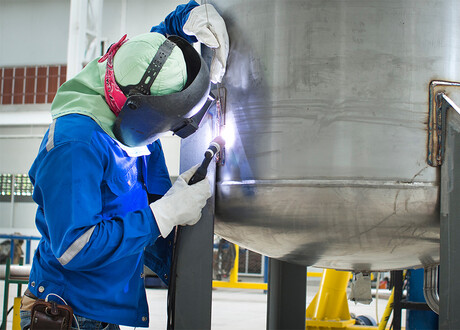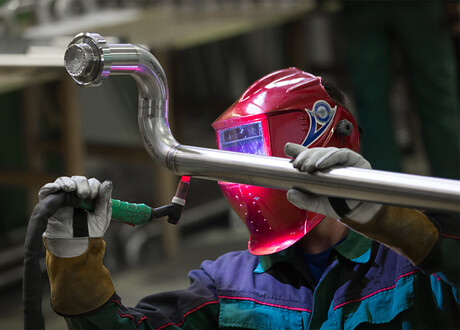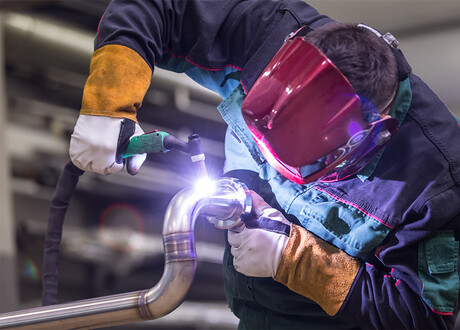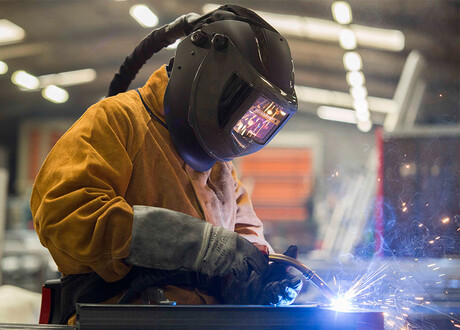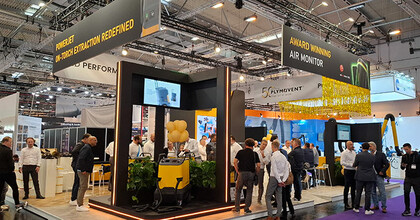What is hexavalent chromium & how to act for best protection.
A recent case (early February 2019) of financial compensation for 800 workers who have been exposed to the hazardous hexavalent chromium in the workshop of the Nederlandse Spoorwegen (NedTrain-department) in Tilburg, the Netherlands, has again put the spotlight on the danger of this substance.
The city of Tilburg has to pay a total of 10 million euros to those that have been exposed to and those that have gotten ill from Chrome 6, working at the Nederlandse Spoorwegen workshop.
Chromium metal is used in many steel alloys to harden the material and make it more resistant to corrosion. Chromium metal itself is not very dangerous, but during welding or grinding the metal is oxidized to hazardous hexavalent chromium. This substance is also used in certain paints and coatings for its corrosion protection. The exposed workers in Tilburg were scraping off this specific paint of old trains. The Nederlandse Spoorwegen is blamed for knowing that this kind of painting was used on the trains but never mentioning it to the city of Tilburg. “Shocking,” concluded the investigators, pointing fingers at both NedTrain and the city that didn’t inquire at all.
Hexavalent chromium in welding fumes
It appears that Chromium 6 is not only to be found in paints and coatings but also in certain types of welding fumes. This means that the health risks could be much greater than previously thought.
The last few years, more and more information about the dangers of hexavalent chromium (Chromium 6) in welding fumes has surfaced. It targets the respiratory system, liver, kidneys, skin, nose, and eyes, and is known to cause cancer and COPD1. Approximately 400,000 workers2 in the Netherlands regularly work in circumstances with welding fumes.
What is Chromium 6 (hexavalent chromium)?
There are various ways to describe the substance. It is often called Chrome 6 or Chromium 6, chromium VI or short Cr(VI). The longer version is hexavalent chromium. The name chromium is derived from the Greek word ‘chroma’ which means colour. In its mineral form, it has been used as a paint pigment since the 18th century.
There are differences between the various forms of chromium. Three forms are the most common ones. Most people will know chromium metal, or Cr(0), from coatings on faucets in bathrooms and the likes, or classic vehicles, and in various alloys.
Cr(III) or trivalent chromium is a natural element found in rocks, animals, and plants. In small doses, it is actually an essential nutrient for the metabolism of carbohydrates and lipids.
Cr(VI) or hexavalent chromium is the hazardous form of chromium. It can be inhaled or swallowed, but it can also penetrate your skin and cause diseases.
Serious consequences: autoimmune diseases and cancer
When hexavalent chromium oxide is dissolved in water, it changes into trivalent chromium. This takes place inside the human body. The harmfulness of this process is determined by its location: inside or outside a cell.
When conversion to trivalent chromium takes place inside a cell, the cell can be harmed, which can lead to a wide variety of health issues. These risks include DNA damage, resulting in autoimmune diseases and cancer.
If the conversion takes place outside a cell, for example in sweat or stomach acid, the process is harmless. However, if there are more hexavalent chromium oxides in the working place, there is a greater chance of hexavalent chromium entering cells and damaging them. So, the more exposure to it, the bigger the chance you may become a victim of Chromium 6.
Where do we find hexavalent chromium?
Exposure to hexavalent chromium in welding fumes is primarily associated with welding stainless steel. That doesn’t mean it is limited to this material. Usually, chromium is not added to other types of steel, but it can be around at low levels, due to the use of scrap steel in the production process. You will find exposure to welding fumes in multiple sectors. Workers in the metal industry, shipyards, construction work, and transportation sector are the possible prime victims.
Welders are not the only ones affected by the hazards of hexavalent chromium. Various other workers in the sectors mentioned above are at risk as well.
Where else is hexavalent chromium being used?
Paint with chromium VI has been used widely to protect military equipment. In recent years, the Dutch Department of Defense reported many incidents related to the workers’ use of hexavalent chromium. When hexavalent chromium is detected while working on equipment or buildings, reports must be filed, and adequate measures must be taken. All reports and measures are made public on a website created by the department.
The dangerous substance can also affect infrastructure projects. A large repair project on a highway bridge in the Netherlands is taking much longer and has more impact on traffic than planned. You can blame this on the hexavalent chromium that was discovered in the paint and the necessary protection measures that had to be taken for both workers and passing traffic.
Appropriate protection against Chromium 6 hazards
In the Netherlands the maximum allowable concentration for hexavalent chromium is 1 µg/m3 for an 8-hr TWA exposure during a 40-hr workweek, for welding fumes in general this is 1 mg/m3.
In the USA the advice is more strict. The NIOSH recommends that airborne exposure to all Cr(VI) compounds be limited to a concentration of 0.2 µg Cr(VI)/m3 for an 8-hr TWA exposure during a 40-hr workweek3.
To make sure your workers aren’t exposed to large amounts of hazardous substances, you must use adequate exhaust ventilation and filtration in your workspace. This does not only apply to welders, but also to workers who have other tasks like cutting, grinding and sanding, or even forklift drivers, maintenance workers and team leaders.
Please see to it that for all welding, cutting, grinding and sanding activities, workers use personal protection equipment (PPE), like PersonalPro welding helmets. Also regular service and maintenance checks (like replacing the filters) are vital to have your extraction system functioning properly.
When it comes to applying paint and coatings, it is best to avoid working with hexavalent chromium. In some areas of work, you have no option but to use it. It is strongly advised to take proper exposure measurements and make sure every worker has the necessary means - ventilation and PPE - to protect themselves and minimize any health risks.
Reduce exposure to welding fumes
There are international standards for the preferred order to in which welding fumes must be captured. First reduction or avoidance of the production of welding fumes. Secondly at-source capture of welding fumes. Then separation of the source and human by automation and e.g. an extraction hood over the welding robot. When the previous is not possible or insufficient, e.g. because of very large work pieces, general ventilation and personal protection is recommended.
But equally important is the correct use of these extraction equipment by the workers and the maintenance of the system by the employer to keep the extraction as effective as anticipated.
For more information please contact us or one of our authorised distributors.

